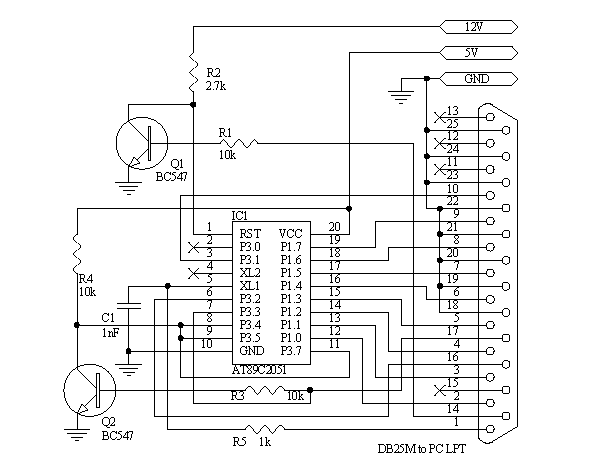Programator Atmel At89c2051

Low-voltage, high-performance CMOS 8-bit microcomputer with 2KB of flash programmable and erasable read-only memory. The device is manufactured using. Atmel 89C2051 In-Circuit Programmer Schematic This is a 'beta release' schematic. Use at your own risk The idea is to add this circuitry to a board with already has ram at 2000 and an 82C55 I/O chip to provide ports A, B and C.
Atmel Flash Micro Programmer My Atmel Flash Micro Programmer Introduction: I have build my own programmer. This device can program the AT89C51 and works with it.
So it can be easily adapted to programming other devices by itself. The Atmel Flash devices are ideal for developing, since they can be reprogrammed easy, often and fast.
You need only 1 or 2 devices in low cost plastic case for developing. In contrast you need 10 or more high cost windowed devices if you must develop with EPROM devices (e.g. Phillips 87C751). The AT89C2051 is the smallest 8051 member with full resources (128 Byte RAM, 2 Timer, UART).
Only the Flash size and pin count is reduced (2kByte, 20 pin case: 15 IO pins available). Now I have build a programmer for these 20 pin devices working with the AT89C2051: The programmer and the PC are connected via a serial port (COM1.4).
Music unlimited powered by qriocity psp software download. With this partial restoration users were able to access to some of the services such as online game play, account management, friend lists and chat functionality were restored.
Well actually, Dattebayo Studio HAS NOT translated it yet, but other people saw it in Japan, because they have already shown the movie.
No Interrupt is used since every data byte from the programmer must be receipt by the PC. So this program can also run under WINDOWS without data loss. Devices: Today following devices can be programmed: • AT89C51 / AT89C52 (at 12V only) • AT89C1051 / AT89C2051 / AT89C4051 • AT90S1200 / AT90S2313 (AVR) • AT89S8252 / AT89S53 • AT89C55 • ATtiny22 (new) Features: • Input: Intel HEX (use converter to load binary) • Autodetection (read signature at 5V, can failed if device locked) • Fast parallel programming (with ready polling) • Batch mode programming • Programming lock and fuse bits • Adding new devices via definition file (PC program must not modified) • full Protection against misinsertion or misselection Using: The using is quite simple. The example file 'proflash.bat' can be used for calling automatically after generating hex file to program in batch mode. In this case the target must be placed in the programmer before compiling started.
Or you place 'uniprog.ini' in the same directory with the 'uniprog.exe' file and make all programming steps manually. On AVR devices the FLASH and EEPROM are programmed together. If only one name is given, the second name for the EEPROM hex file is build by exchanging the extension with '.eep'. You can also give 2 different names for both. On using a comma to separate you can define one or both names empty.

To select the device you can use the autoselect feature. You can also select it by using the up -or 'u'-key or down- or 'd'-key (using characters 'd' or 'u' in batch mode recommend). The programmer is tested under DOS or WINDOWS (3.xx or 95). A 386SX or higher CPU is needed. Other Features: • Return an errorlevel on successful programming • Internal virus check • Baudrate detection, you must give a range e.g. Baud = 00 • The device can given by the number (entry in the definition file) or by its name (e.g.